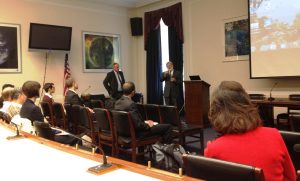The Ecology of Zoonotic Diseases
On April 23, 2013, the Ecological Society of America sponsored a congressional briefing on the ecology of zoonotic diseases. The briefing highlighted the various environmental factors that can contribute to the spread of several prominent animal to human diseases.Presentations were given by Robert Parmenter, Director of the USDA Valles Caldera National Reserve Scientific Services Division and Gregory Glass, Professor at Johns Hopkins School of Public Health and Director of the Alabama Southern Research Institute’s Global Biological Threat Reduction Program.
 Diseases discussed in Parmenter’s presentation included malaria, Lyme disease and hantavirus, a rodent transmitted disease, which has gained prominence in the New Mexico region where he resides. Parmenter explained that some diseases require vectors (usually arthropods like ticks or fleas) while others can be directly transmitted from a host (like the rodent-human spread of hantavirus). He also elaborated on the various ecological conditions that influence zoonotic diseases, such as precipitation and temperature.
Diseases discussed in Parmenter’s presentation included malaria, Lyme disease and hantavirus, a rodent transmitted disease, which has gained prominence in the New Mexico region where he resides. Parmenter explained that some diseases require vectors (usually arthropods like ticks or fleas) while others can be directly transmitted from a host (like the rodent-human spread of hantavirus). He also elaborated on the various ecological conditions that influence zoonotic diseases, such as precipitation and temperature.
Glass talked about the sources of environmental and health data. Multiple federal agencies make detection, monitoring and research of zoonotic diseases possible. These include the National Aeronautics Space Administration, the National Oceanic and Atmospheric Administration, the United States Geological Survey, the Centers for Disease Control, the Environmental Protection Agency, the Departments of Defense, Agriculture and Homeland Security and the US Agency for International Development. Glass also highlighted ways in which ecologists can help predict future zoonotic disease outbreaks and how climate change is likely to affect the distribution of Lyme disease.
The briefing was hosted by the House Science, Space and Technology Committee.
Click here for Robert Parmenter’s slide presentation.
Click here for Gregory Glass’ slide presentation.